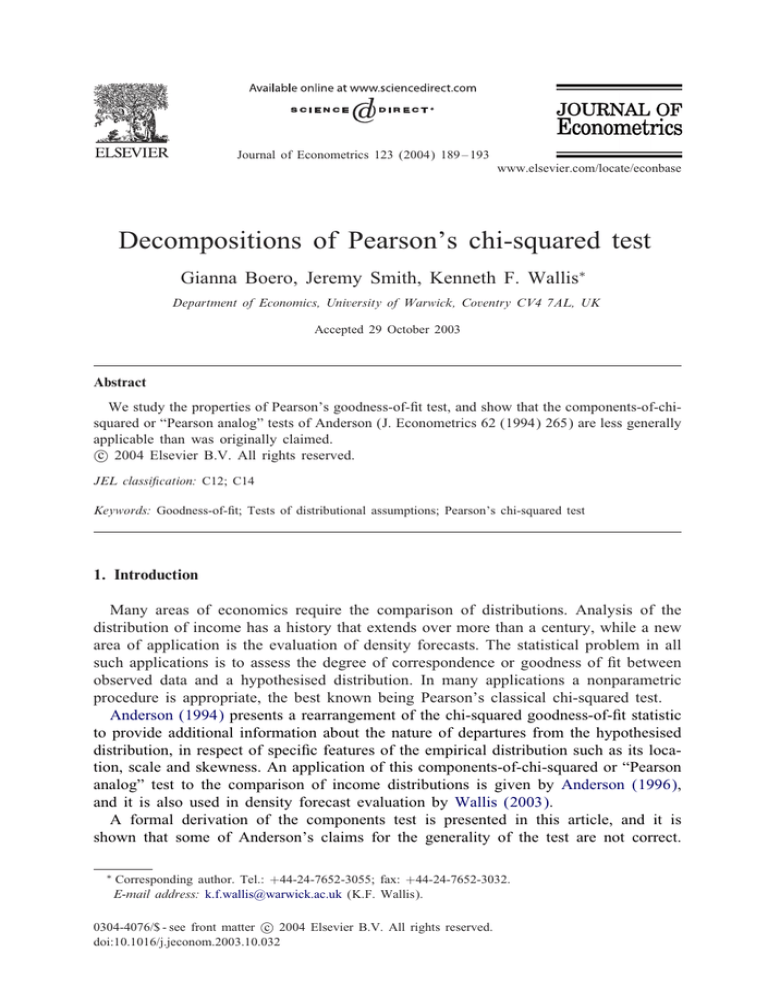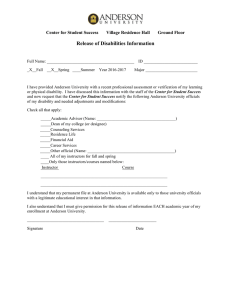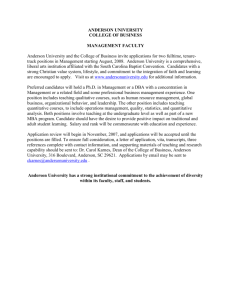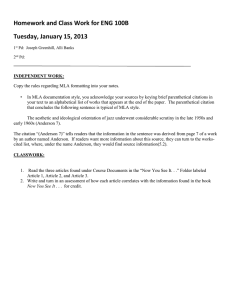
Journal of Econometrics 123 (2004) 189 – 193
www.elsevier.com/locate/econbase
Decompositions of Pearson’s chi-squared test
Gianna Boero, Jeremy Smith, Kenneth F. Wallis∗
Department of Economics, University of Warwick, Coventry CV4 7AL, UK
Accepted 29 October 2003
Abstract
We study the properties of Pearson’s goodness-of-2t test, and show that the components-of-chisquared or “Pearson analog” tests of Anderson (J. Econometrics 62 (1994) 265) are less generally
applicable than was originally claimed.
c 2004 Elsevier B.V. All rights reserved.
JEL classication: C12; C14
Keywords: Goodness-of-2t; Tests of distributional assumptions; Pearson’s chi-squared test
1. Introduction
Many areas of economics require the comparison of distributions. Analysis of the
distribution of income has a history that extends over more than a century, while a new
area of application is the evaluation of density forecasts. The statistical problem in all
such applications is to assess the degree of correspondence or goodness of 2t between
observed data and a hypothesised distribution. In many applications a nonparametric
procedure is appropriate, the best known being Pearson’s classical chi-squared test.
Anderson (1994) presents a rearrangement of the chi-squared goodness-of-2t statistic
to provide additional information about the nature of departures from the hypothesised
distribution, in respect of speci2c features of the empirical distribution such as its location, scale and skewness. An application of this components-of-chi-squared or “Pearson
analog” test to the comparison of income distributions is given by Anderson (1996),
and it is also used in density forecast evaluation by Wallis (2003).
A formal derivation of the components test is presented in this article, and it is
shown that some of Anderson’s claims for the generality of the test are not correct.
∗
Corresponding author. Tel.: +44-24-7652-3055; fax: +44-24-7652-3032.
E-mail address: k.f.wallis@warwick.ac.uk (K.F. Wallis).
c 2004 Elsevier B.V. All rights reserved.
0304-4076/$ - see front matter doi:10.1016/j.jeconom.2003.10.032
190
G. Boero et al. / Journal of Econometrics 123 (2004) 189 – 193
This fact explains some of the unexpected simulation results reported by Anderson
(2001).
2. The chi-squared goodness-of-t test and its components
Pearson’s classical test proceeds by dividing the range of the variable into k mutually
exclusive classes and comparing the observed frequencies with which outcomes fall in
these classes with the expected frequencies
under the hypothesised distribution. With
;
i
=
1;
:
:
:
;
k,
ni = n and class probabilities under the
observed class frequencies
n
i
null pi ¿ 0; i = 1; : : : ; k,
pi = 1, the test statistic is
X2 =
k
(ni − npi )2
i=1
npi
:
This statistic has a limiting 2 distribution with k − 1 degrees of freedom (denoted
2
k−1
) if the hypothesised distribution is correct.
The asymptotic distribution of the test statistic rests on the asymptotic k-variate normality of the multinomial distribution of the observed frequencies. Placing these in the
k × 1 vector x, under the null hypothesis this has mean vector = (np1 ; np2 ; : : : ; npk )
and covariance matrix
−p1 p2
:::
−p1 pk
p1 (1 − p1 )
−p2 p1
p2 (1 − p2 ) : : :
−p2 pk
:
V = n
..
..
..
.
.
.
−pk p1
−pk p2
: : : pk (1 − pk )
The covariance matrix is singular, with rank k − 1: note that each column (row) sums
to zero. De2ning its generalised inverse V − , the limiting distribution of the quadratic
2
(Pringle and Rayner, 1971, p.78).
form (x − ) V − (x − ) is then k−1
In his derivation and application of the components test Wallis (2003) considers the
case of equiprobable classes, as is often recommended to improve the power properties
of the overall test. In this case pi = 1=k; i = 1; : : : ; k and
V = (n=k)[I − ee =k];
where e is a k × 1 vector of ones. Since the matrix in square brackets is symmetric
and idempotent it coincides with its generalised inverse, and the chi-squared statistic
is equivalently written
X2 =
k
(ni − n=k)2
i=1
(n=k)
= (x − ) [I − ee =k](x − )=(n=k)
G. Boero et al. / Journal of Econometrics 123 (2004) 189 – 193
191
(note that e (x − ) = 0). There exists a (k − 1) × k transformation matrix A, such that
AA = I ;
A A = [I − ee =k]
(Rao and Rao, 1998, p.252). Hence de2ning y = A(x − ) the statistic can be written
as an alternative sum of squares
X 2 = y y=(n=k);
where the k − 1 components yi2 =(n=k) are independently distributed as 12 under the
null hypothesis.
To construct the matrix A we consider Hadamard matrices, which are square matrices
whose elements are 1 or −1 and whose columns are orthogonal: H H = kI . For k
equal to a power of 2, we begin with the basic Hadamard matrix
1
1
H2 =
1 −1
and form Kronecker products
H 4 = H2 ⊗ H2 ;
H8 = H4 ⊗ H2
and so on. Deleting the 2rst row of 1s and dividing by
matrix A, that is, H is partitioned as
e
:
H= √
kA
√
k then gives the required
With k = 4, and reordering the rows, we have
1
1
−1 −1
1
1 −1 −1
1
A=
2
1 −1
1
−1
and Anderson (1994) suggests that the three components of the test relate in turn
to departures from the null distribution with respect to location, scale and skewness.
Taking k = 8 allows a fourth component related to kurtosis to appear, although the
remaining three components are diKcult to relate to characteristics of the distribution:
1
1
1
1
−1 −1 −1 −1
1
1
−1 −1 −1 −1
1
1
1
1
−1 −1
1
1
−1 −1
1
1
1
−1 −1
1
A = √ 1 −1 −1
:
8
1 −1 −1
1
−1
1
1
−1
1 −1
1
−1 −1
1
−1
1
1 −1
1
−1
1
−1
1
−1
192
G. Boero et al. / Journal of Econometrics 123 (2004) 189 – 193
Note that the 2rst three components when k = 8 coincide with the (only) three components when k = 4.
Returning to the general case of unequal class probabilities we write the covariance
matrix as
V = n[P − pp ];
where P =diag(p1 ; p2 ; : : : ; pk ) and p=(p1 ; p2 ; : : : ; pk ) . Tanabe and Sagae (1992) give
the result that
[P − pp ]− = (I − ee =k)P −1 (I − ee =k)
hence the test statistic can again be written in terms of the transformed variables
y = A(x − ), as
X 2 = y AP −1 A y=n:
The covariance matrix of y is E(yy ) = AVA , whose inverse AP −1 A =n appears in the
above quadratic form: this can be checked by multiplying out, noting that e [P−pp ]=0
and AP −1 p = Ae = 0. The diagonal elements give the variance of yi ; i = 1; : : : ; k − 1,
as i2 = n(1 − k(ai p)2 )=k where ai is the ith row of A, corresponding to expressions
given by Anderson (1994, p.267) for the 2rst four elements when k = 8. However, the
covariance matrix is not diagonal, hence the test statistic does not reduce to a simple
sum of squares in the case of unequal pi . Equivalently, terms of the form yi2 =i2
are not independently distributed as 2 in this general case, contrary to Anderson’s
claim. It remains the case, however, that the marginal distribution of an individual
yi2 =i2 is 12 .
Anderson (1994) goes on to argue that the power of the component tests to detect
departures of the alternative distribution from the null distribution depends on the
closeness of the intersection points of the two distributions to the location of the class
boundaries. In the equiprobable case the class boundaries are the appropriate quantiles,
and moving them to improve test performance clearly alters the class probabilities. In
practical examples this is often done in such a way that the resulting class probabilities
are symmetric, that is, p1 = pk ; p2 = pk−1 ; : : : ; which is an interesting special case.
Now the odd-numbered and even-numbered components of the chi-squared statistic are
orthogonal. Hence focusing only on location and scale, for example, a joint test can
be based on y12 =12 + y22 =22 , distributed as 22 under the null; similarly, focusing only
on skewness and kurtosis, a joint test can be based on y32 =32 + y42 =42 . As in the more
general case, however, these two test statistics are not independent, equivalently their
sum is not distributed as 42 .
This observation helps to explain some of the simulation results of Anderson (2001),
who includes components-of-chi-squared tests in a comparison of a range of tests for
location and scale problems. With four non-equiprobable classes whose boundaries are
placed symmetrically around the mean, the class probabilities are symmetric in the
sense of the previous paragraph if the null distribution is symmetric, but not otherwise.
The components considered are the individual location and scale components, each of
which is 12 in general; a “joint” test based on their sum, as in the above example,
which is 22 in the symmetric case but not in general; and a “general” test de2ned as
G. Boero et al. / Journal of Econometrics 123 (2004) 189 – 193
193
the sum of the 2rst three components, which is no longer 32 even in the symmetric but
non-equiprobable case. Anderson (2001, p.25) reports that the power and consistency
properties of the various components tests are good, “with the exception of the general
and joint tests under the asymmetric distribution.” The above analysis shows that in
these circumstances the null distributions are not 2 , contrary to what is assumed in the
simulation study, hence the problems noted are the result of comparing test statistics
to inappropriate critical values.
Our own simulations (Boero et al., 2002) show that the use of unequal class probabilities can indeed improve the power of an individual component test, although once
attention has been focused in this way many researchers might alternatively choose to
use a moment-based test.
Acknowledgements
The helpful comments of Gordon Anderson and two anonymous referees are gratefully acknowledged.
References
Anderson, G., 1994. Simple tests of distributional form. Journal of Econometrics 62, 265–276.
Anderson, G., 1996. Nonparametric tests of stochastic dominance in income distributions. Econometrica 64,
1183–1193.
Anderson, G., 2001. The power and size of nonparametric tests for common distributional characteristics.
Econometric Reviews 20, 1–30.
Boero, G., Smith, J., Wallis, K.F., 2002. The properties of some goodness-of-2t tests. Economic Research
Paper No 653, University of Warwick.
Pringle, R.M., Rayner, A.A., 1971. Generalized Inverse Matrices with Applications to Statistics. Charles
GriKn, London.
Rao, C.R., Rao, M.B., 1998. Matrix Algebra and its Applications to Statistics and Econometrics. World
Scienti2c, Singapore.
Tanabe, K., Sagae, M., 1992. An exact Cholesky decomposition and the generalized inverse of the variance–
covariance matrix of the multinomial distribution, with applications. Journal of the Royal Statistical Society
B 54, 211–219.
Wallis, K.F., 2003. Chi-squared tests of interval and density forecasts, and the Bank of England’s fan charts.
International Journal of Forecasting 19, 165–175.








